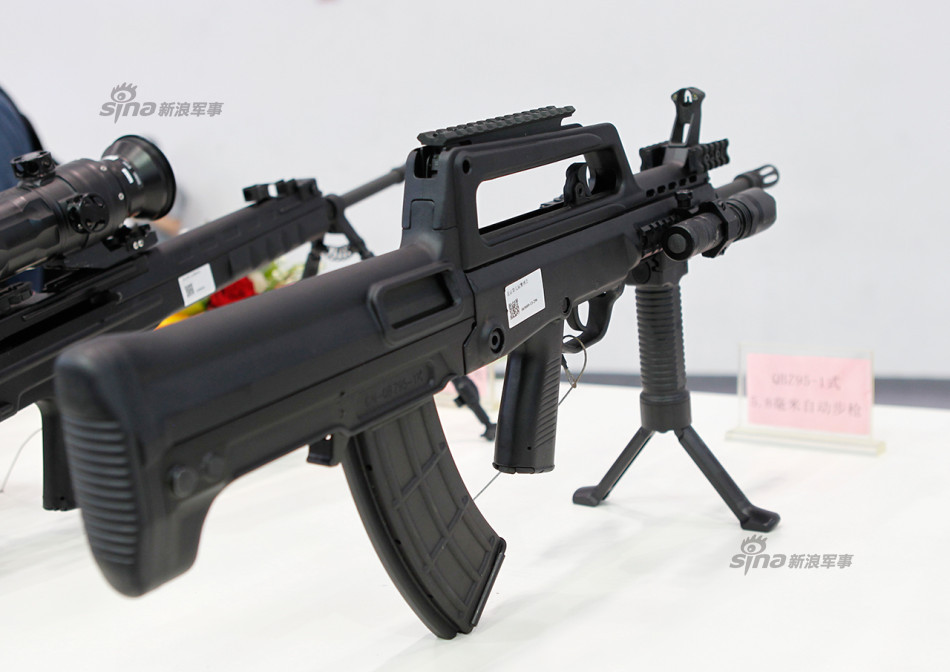This post is also available in:
 עברית (Hebrew)
עברית (Hebrew)
China’s People’s Liberation Army has traditionally relied on foreign and Communist bloc weapons manufactured in China. Now, however, as the PLA undergoes an unprecedented modernization, a new generation of locally designed and manufactured light weaponry is arming China’s armed forces, from handguns to light machine guns.
China’s first modern, home designed and produced assault rifle is the QBZ-95, currently standard issue across the People’s Liberation Army and China’s internal security force, the People’s Armed Police. The weapon first entered Chinese service in the mid-1990s. The QBZ-95 is a so-called “bullpup” rifle, meaning the trigger and fire-control group are placed ahead of the magazine.
Typical of bullpup rifles, the QBZ has a twenty-inch barrel but an overall length of just under thirty inches. This gives it a longer barrel, and slightly longer range and velocity against the American M4 carbine, while at the same time having an overall length three inches shorter than the American gun. The downside of the bullpup design is a fixed length of pull that is not adjustable to a user’s unique arm length and the lack of a viable left-handed shooting ability.
The QBZ-95 is fed from a thirty-round magazine and uses a locally designed 5.8-millimeter×42 round. Exactly why China went through the trouble of designing this round, as both NATO 5.56 and Russian 5.45 rounds are well established is a mystery. It would have been a simple matter to simply copy them and their characteristics. One possible explanation is that, like the Soviet Union, China did not want foreign ammunition to be able to be fired from their weapons.
Internally the QBZ-95 has a short-stroke gas piston, rotating bolt design. In that respect, the insides of the Chinese rifle resembles the Soviet AK-47. In addition to the standard rifle version, there are three variants. A carbine version has a shorter overall length of just twenty-four inches, giving it the compactness of a submachine gun with the stopping power of an assault rifle. A third weapon, the light-support-weapon variant, has an even longer barrel and is equipped with a seventy-five-round drum for delivering suppressive fire.
A new version of the rifle, the QBZ-95-1 features a number of improvements that make for a better, combat-ready rifle for a wider range of users. The improved rifle has a heavier, longer barrel for sustained firing, a muzzle brake to reduce felt recoil and ergonomics that are more friendly to left-handed users.
The PLA still sees value in submachine guns, unlike the armies of the West. The QCW-05 is a submachine gun very similar in external configuration to the QBZ-95, being a bullpup rifle, the main difference being the former uses a shorter, less powerful 5.8×21 round. A curved, quadruple-stack magazine inserted into the stock magazine well feeds fifty rounds to the submachine gun. The QCW-05 is issued to People’s Liberation Army and People’s Armed Police special operations forces and is likely issued to military police units and vehicle crews guarding vital equipment, such as PLA Rocket Forces crews.
According to scout.com, the seeming need for all of China’s modern small arms to use one of many types of 5.8-millimeter ammunition is a mystery. There seems to be no rational reason for this. While Western armies use only 7.62-millimeter ammunition for medium machine guns; 5.56-millimeter ammunition for automatic rifles, assault rifles and carbines; and nine-millimeter ammunition for pistols (and the occasional submachine gun), China has no fewer than four different types of 5.8-millimeter ammunition for light machine guns, assault rifles, submachine guns and pistols. This could create severe logistical problems in wartime, as a curt request for “5.8-millimeter ammo” could result in a large shipment of pistol ammunition to the front line.
China is proclaiming its independence from foreign weapon and ammunition designs with a range of modern weaponry. These weapons are a particular point of pride, as this is the first time in the modern era that China is fully supplied with indigenously designed and produced small arms.


























